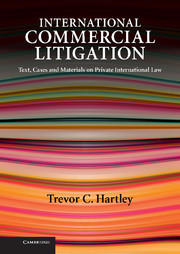Book contents
- Frontmatter
- Contents
- Table of panels
- List of figures
- Preface
- Acknowledgments
- Terminology
- Table of Latin phrases
- List of abbreviations
- Table of cases
- Table of cases (European Court of Justice, numerical order)
- Table of legislative instruments
- PART I STARTING OFF
- PART II JURISDICTION
- PART III FOREIGN JUDGMENTS
- PART IV PROCEDURE
- PART V CHOICE OF LAW
- PART VI EXTRATERRITORIALITY
- 32 Introduction to Extraterritoriality
- 33 Extraterritorial application of US antitrust law
- 34 The international response
- 35 Extraterritorial application of EC competition law
- Bibliography
- Index
33 - Extraterritorial application of US antitrust law
from PART VI - EXTRATERRITORIALITY
- Frontmatter
- Contents
- Table of panels
- List of figures
- Preface
- Acknowledgments
- Terminology
- Table of Latin phrases
- List of abbreviations
- Table of cases
- Table of cases (European Court of Justice, numerical order)
- Table of legislative instruments
- PART I STARTING OFF
- PART II JURISDICTION
- PART III FOREIGN JUDGMENTS
- PART IV PROCEDURE
- PART V CHOICE OF LAW
- PART VI EXTRATERRITORIALITY
- 32 Introduction to Extraterritoriality
- 33 Extraterritorial application of US antitrust law
- 34 The international response
- 35 Extraterritorial application of EC competition law
- Bibliography
- Index
Summary
Introduction
In this chapter, we will discuss the international reach of US antitrust law, that is to say, the extent to which American courts have held that US antitrust law applies extraterritorially. Antitrust law, an area on the border between public and private law, has been chosen because it has given rise to particular friction between the US and the international community. In the next chapter, we will discuss the reaction of other countries to what they perceive as the excessively wide reach of US law.
Antitrust law (called ‘competition law’ in Europe) was an American innovation. The Sherman Act, adopted in 1890, prohibits monopolies and conspiracies in restraint of trade. It applies only to inter-state and international commerce. It is supplemented by other statutes, including the Clayton Act (1914), which creates further offences – for example, discrimination in price, services or facilities. US antitrust law has both a criminal and a civil aspect: in criminal proceedings, the accused may be fined or imprisoned; in civil proceedings, private parties may bring actions in tort for treble damages. Injunctions may also be obtained.
Originally regarded with suspicion in Europe, antitrust/competition law is today recognized as an essential feature of an advanced economy. Similar legislation has been adopted in many European countries; it is also important in EC law. We will consider the international reach of EC competition law in Chapter 35.
- Type
- Chapter
- Information
- International Commercial LitigationText, Cases and Materials on Private International Law, pp. 810 - 831Publisher: Cambridge University PressPrint publication year: 2009



